Author: @DavideCrapis
Translation: Deconstructing Rollup Economics
Have you ever wondered how Rollup generates such astonishingly high levels of income?
Base achieved over $2 million in revenue in less than 3 weeks… Inspired by @DavideCrapis's recent post titled "Rollup Economics 2.0," let's delve into the economic model of Rollup.
Key points of this article:
1) The "old-school" business model of Rollup
2) How Rollup design becomes more complex
3) Interoperability
4) The role of Layer 3
The image below describes the "old-school" model of Rollup as an income-generating model. As you can see, the system consists of three main components:
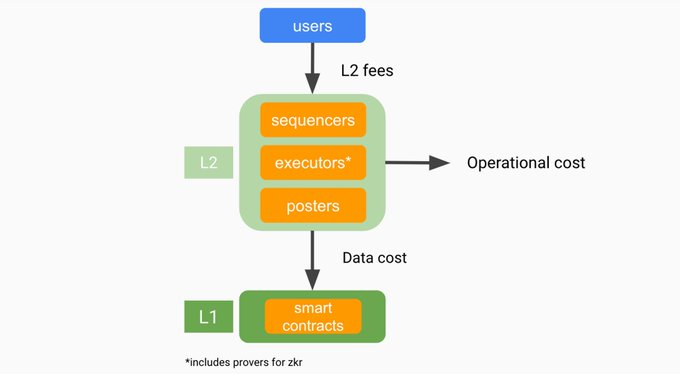
- Users
- Rollup operators (sequencers, executors, publishers)
- Layer 1 (L1)
How it works: This flowchart shows users paying L2 fees (gas costs), operational costs (computational costs, servers, etc.), and data costs (processing transactions back to L1).
Therefore, users pay fees to generate income, subtracting operational and data processing costs, resulting in profit.
For Rollup, a dilemma is: to create a balanced environment or to pursue profit?
Each DAO/core team behind it must make critical design decisions around optimizing L2 fees, redistributing MEV (Miner Extractable Value), and reducing data costs.
To retain profits or to give back to the community?
This is where Rollup is becoming more complex, aiming to increase security through shared governance, increase efficiency through a shared economy, and improve user experience by reducing liquidity fragmentation. For example, @arbitrum has been gradually pushing for decentralizing its sequencer, but recently, the community found that this is not their top priority, as shown below…
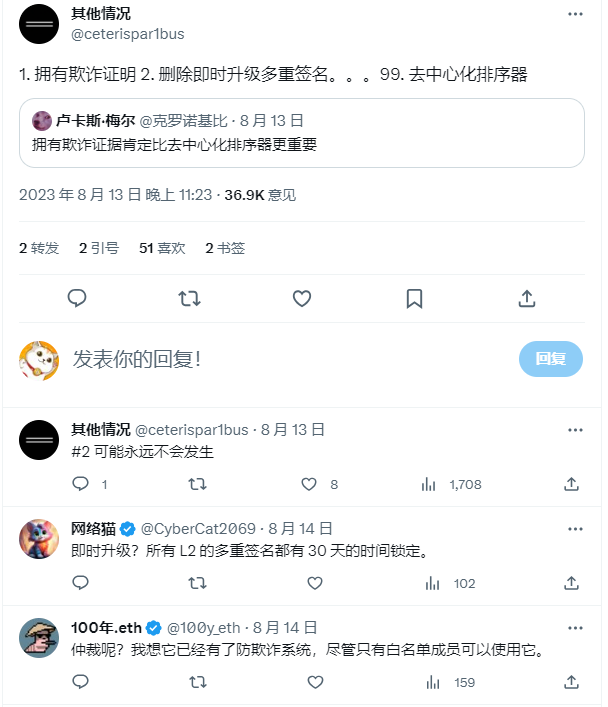
In fact, Rollup faces trade-offs in three areas:
1) Sequencing -> operational costs of decentralization + cost of incentivizing participants.
2) Data availability -> costly to publish data on L1.
3) State verification -> zkRollups have instant finality, but maintaining this feature also requires significant costs.
Teams need to make choices among various trade-offs. As a user, understanding these choices is always in my best interest.
Security is obviously paramount. But what if your users choose to use another chain that is cheaper and faster, but less concerned about security? This is the dilemma for builders?♂️
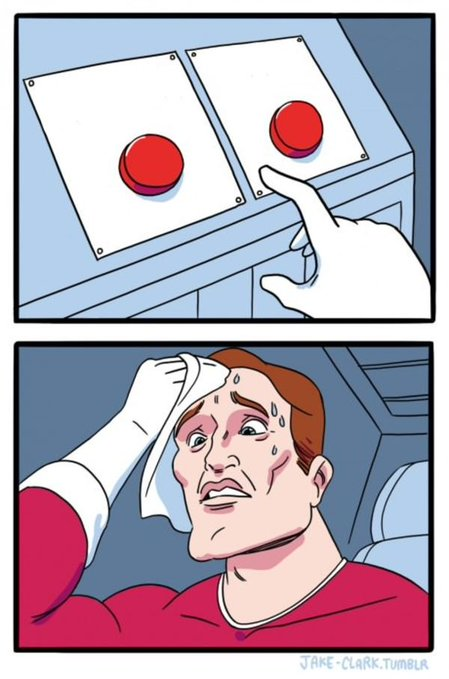
You see, this is why I sympathize with the builders in this space. The true decentralization ethos of some high-quality teams is often overshadowed by marketing, hype, and short-term views. That's life, and it's a competitive market. However, we will see who will prevail in the long run…
Back to this dilemma, and the solution proposed by @DavideCrapis: aggregation.
Shared sequencing, batch publishing, and proofs are at the forefront of optimization. These measures improve efficiency by reducing data costs. For Rollup, future collaboration seems like an undisputed choice.
But does this bring security risks? What if the sequencer crashes? Or the prover fails to operate? These are tough questions. But one thing is certain: collaboration in Rollup can enhance economic productivity. Shared services can lower costs, simplify transactions, and promote healthy growth.
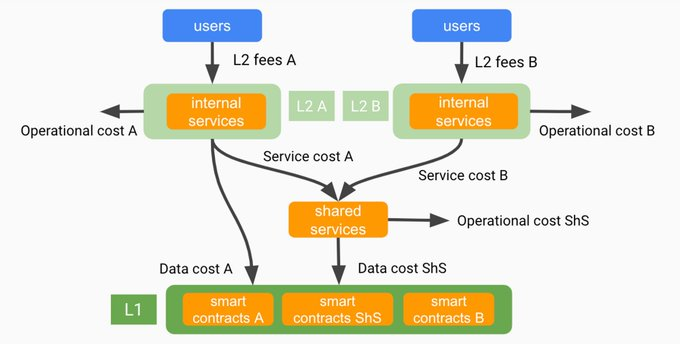
The reasoning is simple, as shown in the chart above, you now have two sets of user fees, but only one shared service cost.
The formula is simple, as described by @DavideCrapis:

The proposed "Rollup Alliance" idea is quite exciting. In a perfect world, Rollups within the same "alliance" would naturally embrace shared services, as the direct data publishing costs would be shared among them.
These Rollup shares bridge with L1, sharing all service and data publishing costs. This will become very powerful after EIP4844.
Examples of this are the architecture designs of @zksync's superchain, @OxPolygonDeFi's supernetwork, and @Starknet. The core concept is: 'infinite' scaling, shared bridging, and aggregating costs among each individual Rollup.
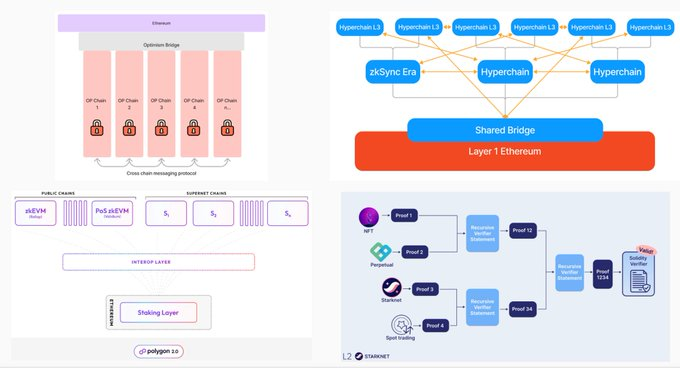
Finally, we have Layer 3. These are very interesting for specific community-specific use cases. Such as gaming, social media, and so on. The reason is that they do not require the high compatibility of decentralized exchanges (DEX) or money markets. Therefore, they can operate in their own execution environment, enjoying very low costs and high transaction speeds. These Layer 3 (L3) will "roll up" to Layer 2 (L2), paying the lowest bundling fees (as the gas costs of Layer 2 are very cheap).
In terms of the economic model, the fees of Layer 3 (L3) become an additional source of income for Layer 2 (L2), increasing their overall income.
Furthermore, more users = teams are more likely to capitalize on opportunities to sell products, mint NFTs, or create profitable dApps.
Charging more fees is shown in the image below:
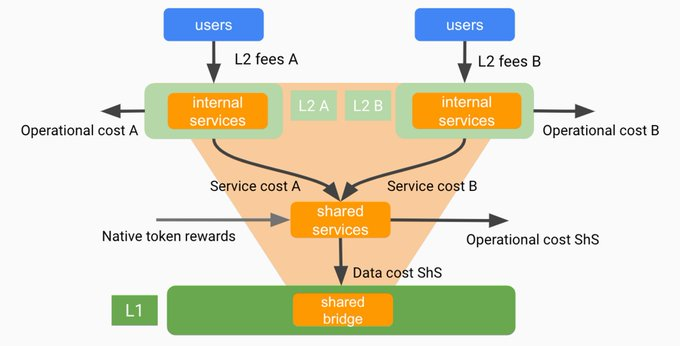
Costs associated with L2 are similar, including computational/operational costs and data costs.
For L2, undoubtedly, deploying L3 to increase income, develop applications that more users need, and create new layers is a wise choice!
In the Rollup space, it is now a very exciting time :)
免责声明:本文章仅代表作者个人观点,不代表本平台的立场和观点。本文章仅供信息分享,不构成对任何人的任何投资建议。用户与作者之间的任何争议,与本平台无关。如网页中刊载的文章或图片涉及侵权,请提供相关的权利证明和身份证明发送邮件到support@aicoin.com,本平台相关工作人员将会进行核查。




